2018 Porsche Panamera
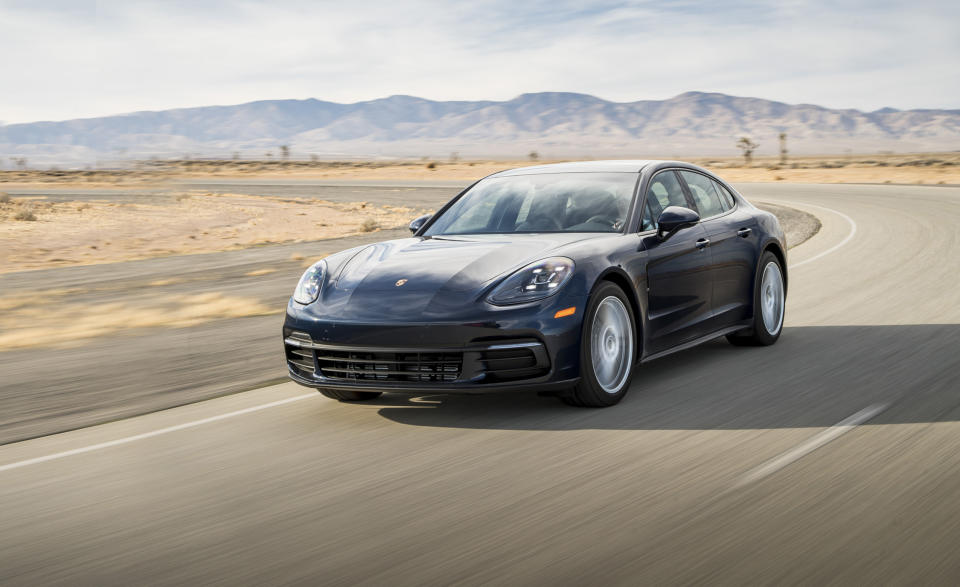
We caught the three Porsche 911s on Mulholland Highway. Up front was a black 930 Turbo, followed by a red 993 S (easily identified by its split rear grille) and then a silver 991 Carrera wearing black aftermarket wheels. We had been following them for about a mile when their pace suddenly quickened. Someone finally looked in the mirror, saw the 2018 Porsche Panamera we were driving, and kicked it up a notch.
We were all doing the same thing: playing hooky on a sunny and warm Tuesday morning to drive Porsches in the twisties above Malibu. Ah, Southern California in February.
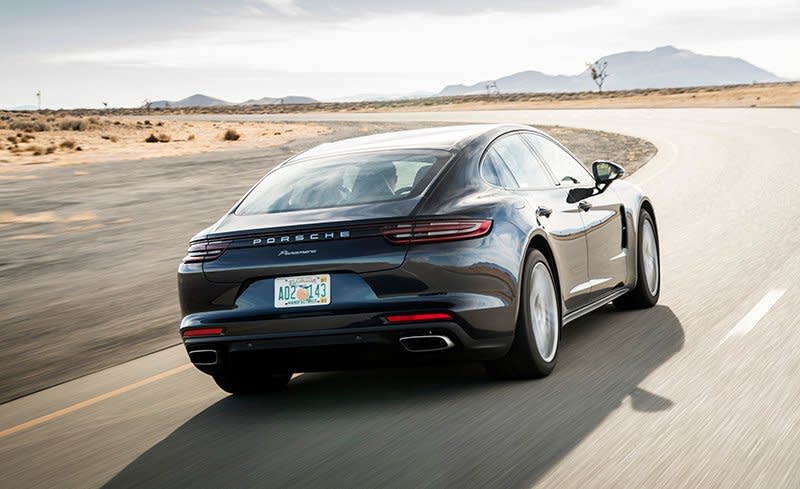
Their inability to pull away from our two-ton sedan was an apparent frustration for the chap in the late-model 911. Twice he backed it all the way down to create a gap from his friend in the 993 before running hard in an attempt to pull away from our family-friendly four-door. But we saw the move coming. Sport+ mode engaged. Porsche Stability Management off. PDK in manual. Sorry, buddy, we’re still here.
This year, Porsche has added nine new models to its second-generation Panamera lineup. There are now 16 variations and five distinct powertrains, including a 680-hp plug-in hybrid. Our test vehicle, a base Panamera, is the only rear-wheel-drive version of the sedan and one of four models powered by a single-turbo 3.0-liter V-6 (also available are all-wheel-drive versions of the sedan, the long-wheelbase Executive variant of the sedan, and the Sport Turismo wagon). With a base price of $86,050, this is the least expensive Panamera (all-wheel drive adds $4600), and it’s also several grand less expensive than our new friend’s 911 Carrera.
Quicker Than a 993
This new single-turbo V-6 is shared with other models in the Volkswagen Group, for example the Audi S4, and puts out 20 ponies more than the naturally aspirated 3.6-liter V-6 that powered the base model of the first-generation Panamera. Its 330 horsepower arrives at 5400 rpm and holds strong through 6400 revs. Torque output has been radically improved as well, from 295 lb-ft at 3750 rpm to 331 lb-ft arriving barely off idle at 1340 rpm. The engine is pleasingly strong in the bottom of the tach but comes alive above 4000 rpm, although it’s not as explosive as the 440-hp twin-turbo 2.9-liter V-6 in the Panamera 4S, let alone the nearly twice as costly 550-hp stick of dynamite that is the Panamera Turbo. The V-6 pairs with the eight-speed version of the brand’s PDK dual-clutch automatic transmission, which is used in every new Panamera.
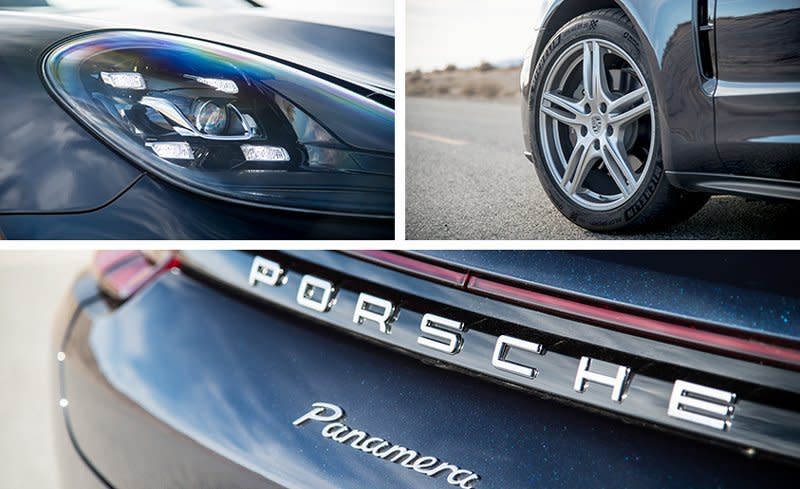
Porsche says the base Panamera can get to 60 mph in 5.2 seconds and through the quarter-mile in 13.9 when equipped with the $2270 Sport Chrono package. But the gang at Weissach must have performed its testing with the hatchback hauling kegs of Stuttgart’s best weissbier, because our test car was much quicker than that. Employing its launch-control system (part of the Sport Chrono pack), which revs and holds the engine to 5000 rpm until the driver steps off the brake pedal, this Panamera hit 60 mph in just 4.7 seconds and covered the quarter-mile in 13.3 seconds at 107 mph. Those times are well over a second slower than today’s 991-generation 911 Carrera but quicker than what we recorded when we tested a manual 993 Carrera 4S back in 1996.
Riding on optional 20-inch wheels from the Panamera Turbo ($1790) and a staggered set of Michelin Pilot Sport 4 rubber measuring 275/40ZR-20 in front and a massive 315/35ZR-20 in the rear, the Panamera also generated 0.97 g of grip on our skidpad, a whisker shy of the 0.99 g generated by a new 911 Targa 4 we tested recently.
Very Well Balanced
In the mountains the Panamera felt big at first, but the grip is there, and the big Porsche seems to shrink as you up the pace. The Porsche Stability Management is tuned conservatively, shutting things down vehemently before any of the Panamera’s athleticism can be explored. The system is far more forgiving in Sport mode, which allows for some hustle, but the Porsche is best with the system turned off, letting the driver set up for corners with a little trail braking.
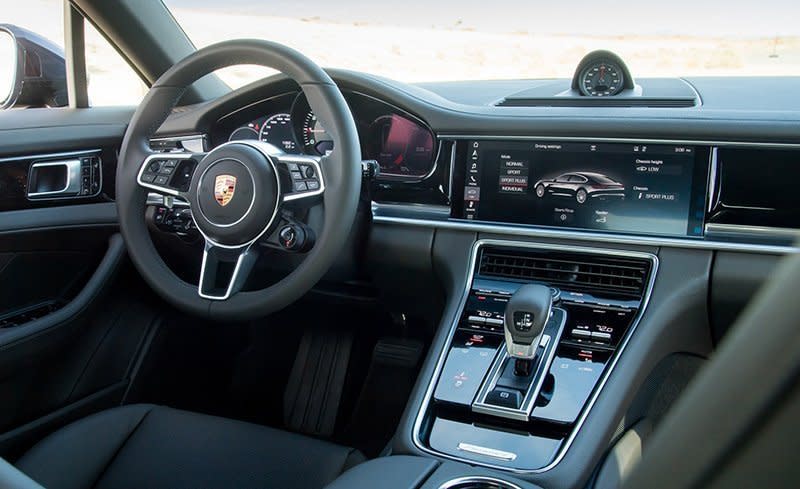
With rear-wheel drive, the base Panamera, lacking the front-axle grunt to pull it through corners, pushes moderately at the limit. It’s easy to place, however, and a slight lift off the throttle tucks its nose toward apexes. At 4223 pounds and 198.8 inches long, it’s happiest in faster sections, where it shows impressive stability and an indifference to midcorner ruts and bumps. But the Panamera also works surprisingly well in the tight stuff despite its lengthy 116.1-inch wheelbase. Our test car was equipped with the optional rear-wheel steering ($1620), which certainly quickened its reactions in slow-speed corners.
And its brakes are up to the task. Porsche fits the Panamera with the same 13.8-inch front and 13.0-inch rear cross-drilled and vented rotors as the 911 GTS, along with six-piston front and four-piston rear calipers. In our testing, the setup showed incredible heat resistance and zero fade, and the sizable hatch stopped from 70 mph in 156 feet. In the hills, they’re easy to modulate with a sure, firm pedal.
Long-Range Cruiser
The PDK’s second-gear ratio is a little short even for the tight sections, which forces third-gear corner entries when the top of second would be preferable. This allows the engine speed to dip below 4000 rpm, compromising the V-6’s readiness when you get back to the throttle. Also, around town in Normal mode, the transmission upshifts to second gear almost immediately and slips its clutch noticeably in slow maneuvers, which makes the big four-door feel artificially lazy. It’s a concession to fuel economy that can be corrected quickly by engaging Sport mode. Interestingly, Porsche says the 164-mph top speed is achieved in sixth gear because the top two ratios are so tall.

Out on the interstate, this is a grand-scale grand tourer. The Panamera swallows entire states whole with its massive 23.7-gallon fuel tank supplying what should be more than 600 miles of range if you’re gentle. The next time you’re driving from L.A. to Texas for some BBQ, this is the ride to have.
We averaged 20 mpg with the car, a number that included our hot stint in the hills. The Panamera’s combined EPA estimate is 24 mpg. The car’s stop/start feature, which shuts off the engine in Normal mode to save fuel at red lights, is smoother than many.
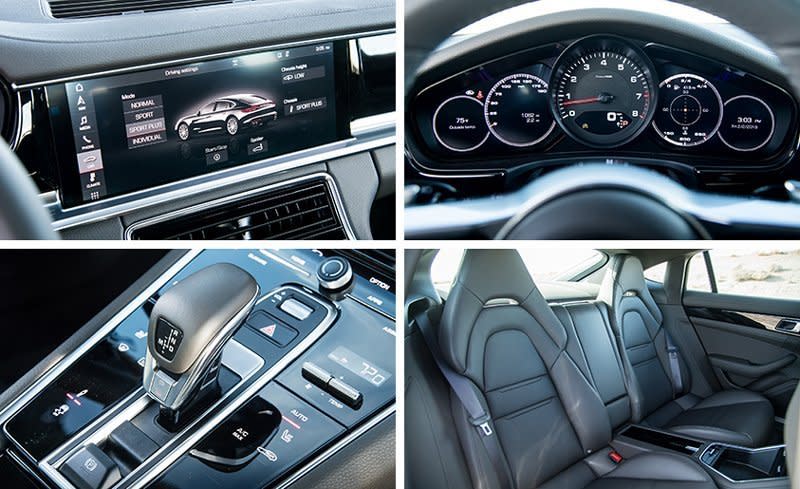
Smooth Ride
Steering feel isn’t really a strong suit but ranks on the good end of the big-luxury-sedan spectrum. Our test car, which stickered for $96,230, was also equipped with the available adaptive air suspension and the accompanying Porsche Active Suspension Management system ($2190). The long-travel setup rides a little high in Normal mode, but its 3.5 inches of front travel and 4.3 inches of rear travel soak up the road with a deft touch while still supplying plenty of road feel. In Low mode, the front suspension hunkers down 2.6 inches and the rear suspension drops 2.0 inches. The suspension also stiffens but manages to keep the ride pleasant and its tires planted over midcorner ripples.
If we had a winning Powerball ticket, our Panamera of choice almost certainly would be the all-wheel-drive Turbo S E-Hybrid Sport Turismo. That 680-hp plug-in hybrid monster hits 192 mph and can be driven about 30 miles on electricity alone. But the base rear-wheel-drive Panamera, which is more than $100,000 less expensive, is an impressive consolation prize. Comfortable and quick, this is Germany’s sportiest large sedan for the money, and it’s a heck of a lot of fun in the hills on a warm Tuesday morning in February.
Specifications >
VEHICLE TYPE: front-engine, all-wheel-drive, 4-passenger, 4-door hatchback
PRICE AS TESTED: $96,230 (base price: $86,050)
ENGINE TYPE: turbocharged and intercooled DOHC 24-valve V-6, aluminum block and heads, direct fuel injection
Displacement: 183 cu in, 2995 cc
Power: 330 hp @ 6400 rpm
Torque: 331 lb-ft @ 1340 rpm
TRANSMISSION: 8-speed dual-clutch automatic with manual shifting mode
DIMENSIONS:
Wheelbase: 116.1 in
Length: 198.8 in
Width: 76.3 in Height: 56.0 in
Passenger volume: 96 cu ft
Cargo volume: 18 cu ft
Curb weight: 4223 lb
C/D TEST RESULTS:
Zero to 60 mph: 4.7 sec
Zero to 100 mph: 11.6 sec
Zero to 140 mph: 25.6 sec
Rolling start, 5–60 mph: 5.5 sec
Top gear, 30–50 mph: 3.0 sec
Top gear, 50–70 mph: 3.6 sec
Standing ¼-mile: 13.3 sec @ 107 mph
Top speed (drag limited, mfr's claim): 164 mph
Braking, 70–0 mph: 156 ft
Roadholding, 300-ft-dia skidpad: 0.97 g
C/D FUEL ECONOMY:
Observed: 20 mpg
EPA FUEL ECONOMY:
Combined/city/highway: 24/21/28 mpg

 Yahoo Autos
Yahoo Autos 